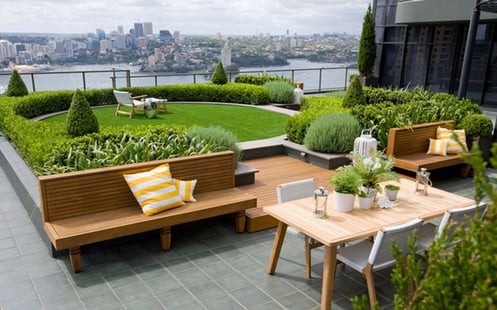Rooftop gardens are popping up all over cities in North America, Europe, the Middle East, and Asia as urban developments grow. In some European countries, there are even laws to dictate that new buildings must have at least an element of greenery, for both commercial and residential properties.
They’re great for us as well as the environment and look fantastic when designed well, so let’s help you get started with your own rooftop garden!
What is a Rooftop Garden?
Rooftop gardens are green areas on the top of buildings that can be used as herb gardens, vegetable gardens, restaurants, or private areas for relaxation away from the hustle and bustle of the city. Usually, roofs are wasted space, so, if possible, it’s an excellent idea to utilize them and make them your own.

Most rooftop gardens comprise plant pots or containers as these are the easiest to install due to their portable nature and lightweight, however, green roofs are also possible. Green roofs have soil, turf, and plants planted directly on top of the roof and therefore are more difficult to build and cannot be done without landscape architects. However, they are absolutely worth it!
What's the Point?
Not only do rooftop gardens provide us with much-needed access to greenery and nature when we get tired of the city, but they also provide a habitat for wildlife and numerous other benefits to the environment. Green roofs provide insulation from heat, cold, and sound which reduces the need for heating and air conditioning, as well as has a cooling effect on cities themselves which decreases the urban heat island effect.

Residential rooftop gardens are great for some quiet time away from busy city life, especially when the parks are full, and the days are long and hot. Commercial rooftop gardens can be great for an outdoor meeting or a peaceful lunch break or just relaxing before a commute. Restaurants and bars can dine out on rooftop gardens too, making the most of containers and trellises as partitions and adding something unique to your visitors’ dining experience.
What can beat an excellent view of the city while being surrounded by nature?
How do you create a rooftop garden?
When designing a rooftop garden, the top priority is to consider the structural integrity and statics of the building. Rooftop gardens can weigh a lot, especially when plants reach their full growth and after being watered, so you’ll need an expert to assess and approve the building’s roof for a garden. The materials used also have to be considered, as terracotta or clay pots can be very heavy so wooden or plastic alternatives are recommended. Although you need to be careful with lightweight plastics as strong winds can easily displace them.
Green roofs can even weigh up to 40kg per 10cm2 depending on static properties so, are usually only recommended for new builds as they can be designed to take the weight of the soil and have built-in drainage and irrigation systems to properly care for the turf and plants. Landscape architects and structural engineers who can assess a building's static calculations should definitely be involved in the process.
For all kinds of rooftop gardens, sun exposure needs to be thought about. Drought-resistant plants like succulents love the sunshine and don’t require much water so make for excellent rooftop foliage as well as perfect in a time when water scarcity is a real issue. Other sun-loving plants include tomatoes and strawberries, which are especially great in restaurants as they are fruit-bearing, proving the freshness of ingredients and commitment to sustainability.

When caring for your rooftop garden, mulch works wonders to add nutrients to soil as well as retain water for your plants. Top-dressing of the soil should be done every spring to avoid plant malnutrition. Rooftop gardens don’t have to be in full sun, however, as shown by the Crossrail roof garden in Canary Wharf which expertly uses netting to shade plants and visitors while still allowing airflow. Pergolas have a similar effect and can look stunning with vines growing over them.
Trellises work wonders to provide shade to some plants and seating areas but also to add some privacy. A dense vine-like climbing honeysuckle can look fantastic with splashes of pink and yellow while keeping your relaxation area secret from surrounding buildings. They can also make great partitions in dining areas too!
Lighting should also be a consideration for late nights or to make your plants stand out. If your project is a new build, dramatic lighting can be added in the design stage, however, if your rooftop garden is an addition to your property, gentle fairy lighting or solar-powered lamps can be very effective.
Are rooftop gardens expensive?
Rooftop gardens can be expensive, but it depends on what style you choose. Green roofs have a bigger installation process, while the price of container gardens will depend on materials and the number of hardscaping features used such as furniture and lighting.
What’s the catch?
If you’ve done your research and called in the experts, there is no catch to rooftop gardens - they really are as great as they seem! One thing to be careful of, however, is that while most pests such as rabbits, rats, and other mammals might be eliminated through having a rooftop garden, some pets like flying bugs and plant disease can still travel and will have to be prevented or treated as you would with any other landscape or yard.
I’m in! How do I start?
Since you need approval before beginning any home rooftop garden or green roof due to the pressure it can put on your property, you’ll have to call in the experts. Likewise, for new or redesigned commercial property, it’s essential to have a landscaper on board the project.
Like us!
At Karaoglu landscape, we have designed, installed, and maintained many rooftop gardens for commercial and residential properties and we think we’ve got what it takes to do yours too. To check out our previous work, head over to our gallery pages here, or to schedule a free consultation, click here.
![karaoglu-web-footer[7].webp](https://blog.karaoglu.com.tr/hubfs/karaoglu-web-footer%5B7%5D.webp.png)
